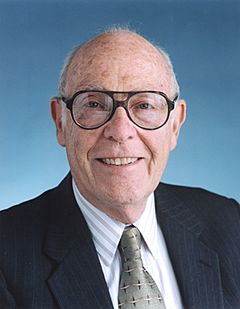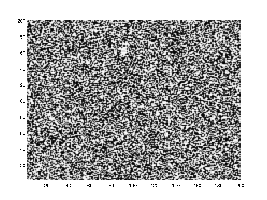John W. Cahn facts for kids
Quick facts for kids
John W. Cahn
|
|
|---|---|

John W. Cahn
|
|
| Born |
Hans Werner Cahn
January 9, 1928 Cologne, Prussia
|
| Died | March 14, 2016 (aged 88) |
| Nationality | American |
| Alma mater | University of Michigan University of California at Berkeley |
| Known for | Allen–Cahn equation |
| Spouse(s) | Anne Hessing Cahn |
| Scientific career | |
| Fields | Metallurgy |
| Institutions | Massachusetts Institute of Technology National Institute of Standards and Technology |
| Doctoral advisor | Richard Edward Powell |
| Influenced | Gretchen Kalonji |
John Werner Cahn (born January 9, 1928 – died March 14, 2016) was an American scientist. He won the National Medal of Science in 1998.
Cahn was born in Cologne, Germany. He taught at the Massachusetts Institute of Technology (MIT) from 1964 to 1978. Later, he worked at the National Institute of Standards and Technology. John Cahn greatly influenced how we study materials. He was an expert in thermodynamics, which is the study of heat and energy. He used its rules to explain and predict many natural events.
Contents
John Cahn's Life Story
Hans Werner Cahn was born in Cologne, Germany. His family was Jewish. His father was a lawyer who opposed the Nazis. His mother worked with X-rays.
In 1933, the Nazis came to power. John's father was warned and escaped arrest. The family left Germany and went to Amsterdam. In 1939, they moved to America. Hans then became John. Sadly, most of his family in Europe were killed in the Holocaust.
The Cahns settled in New York City. John Cahn became an American citizen in 1945. He served in the United States Army in Japan after World War II.
John Cahn studied chemistry at the University of Michigan. He earned his bachelor's degree in 1949. In 1953, he got his Ph.D. in physical chemistry from the University of California, Berkeley. His Ph.D. work was about how hydrazine oxidizes.
In 1954, Cahn joined General Electric in Schenectady, New York. He worked on chemical metallurgy research. This group studied how materials change from one form to another.
In 1964, Cahn became a professor at MIT. He taught in the Department of Metallurgy. He left MIT in 1978. In 1969, he started working with his student, Francis Larché. Their work helped explain how stress affects the energy of solid materials.
In 1972, Cahn worked with David W. Hoffman. They created a way to describe the energy of surfaces in materials. This was important for understanding how different materials interact.
In 1975, Cahn worked with his student Sam Allen. They studied how iron alloys change their structure. This led to the famous Allen–Cahn equation.
From 1984, he was a visiting professor at the University of Washington.
John Cahn's Scientific Work
How Materials Separate
In 1957, Cahn worked with John E. Hilliard. They created the Cahn–Hilliard equation. This equation helps explain how materials separate into different parts. Think of oil and vinegar separating in salad dressing. This work also led to the theory of spinodal decomposition.
How Crystals Grow
Cahn studied how crystals grow. He found that a crystal's surface needs a certain "push" to grow. If the push is strong enough, the surface can grow smoothly. If it's not strong enough, the crystal grows step by step. This depends on how "fuzzy" or "sharp" the crystal's surface is.
Droplets and Surfaces
In 1977, Cahn wrote about how liquids interact with solid surfaces. This is called wetting. His work explained when a liquid forms a droplet on a surface or spreads out as a thin film. This theory was very useful for many ways of processing materials.
Quasicrystals
In 1982, a scientist named Dan Shechtman found a new type of crystal. It had a strange structure. Cahn helped explain how these new materials, called quasicrystals, could be stable. He was a co-author on the important paper that introduced them.
Glassy Materials
In 2004, Cahn and Bendersky found evidence of a new type of metallic glass. They called it "q-glass." This glass forms from melted metal very quickly. It grows in a round shape and looks like glass. This discovery showed that glass can form in a new way.
Later Research
After retiring, John Cahn became a visiting professor at the University of Washington. He worked in the Departments of Materials Science and Engineering and Physics.
Personal Life
John Cahn had three children and six grandsons. He lived in Seattle, Washington, with his wife, Anne Hessing Cahn. He passed away from leukemia in Seattle on March 14, 2016.
Awards and Honors
John Cahn received many awards for his scientific work:
- 2011: The Kyoto Prize, Inamori Foundation
- 2002: Bower Prize, Franklin Institute
- 2001: Emil Heyn Medal, German Metallurgical Society
- 2001: Honorary Life Member, American Ceramic Society
- 1999: Bakhuys Roozeboon Lecturer and Gold medal, Netherlands Academy of Sciences
- 1998: National Medal of Science
- 1998: Member, National Academy of Engineering
- 1998: Distinguished GE Lecturer in Materials Science at RPI
- 1969 & 1998: MacDonald Lecturer, Canadian Metallurgical Society
- 1996: Doctor Honoris Causis, Universite d'Évry, France
- 1995: Harvey Prize, Technion.
- 1994: Rockwell Medal; Hall of Fame for Engineering, Science and Technology, and Medal, International Technology Institute.
- 1994: Gold Medal, Honorary Member, Japan Institute of Metals.
- 1993: Inland Steel Lecture, Northwestern University.
- 1993: Hume–Rothery Award, TMS.
- 1993: Cyril Stanley Smith Lecturer, University of Chicago.
- 1992: Honorary member, MRS-India.
- 1991: Michelson–Morley Award, Case Western University.
- 1990: Honorary Sc. D., Northwestern University; Hilliard Lecturer.
- 1989: Sauveur Award, ASM International.
- 1987: Distinguished Physics Lecturer, Boston University.
- 1986: Stratton Award, National Bureau of Standards.
- 1985: Von Hippel Award, Materials Research Society.
- 1984: Gold Medal, US Department of Commerce.
- 1983: Distinguished Lecturer, University of Connecticut.
- 1982: Golick Lecturer, University of Missouri, Rolla, MO.
- 1981: Fellow, Japan Society for the Promotion of Science.
- 1981: Dickson Prize, Carnegie–Mellon University.
- 1980: Honorary Professor, Jiao Tong University, Shanghai, China.
- 1979: Van Horn Lecturer, Case-Western University.
- 1978: Dorn Lecturer, Northwestern University.
- 1977: Acta Metallurgica Gold Medal.
- 1974: Fellow, American Academy of Arts and Sciences.
- 1973: Member, National Academy of Sciences.
- 1968: Institute of Metals Lecturer, AIME.
- 1966: S. B. Meyer Award, American Ceramic Society.
- 1960–61: Guggenheim Fellowship spent at the University of Cambridge, Goldsmith Laboratory.
- 1951: Allied Chemical and Dye Fellowship at University of California, Berkeley.
See also
 In Spanish: John W. Cahn para niños
In Spanish: John W. Cahn para niños


